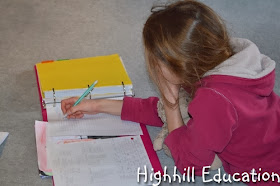Renaissance Unit Study
Week 9: We created Petrarchan Sonnets.Problems and resolution are two key features of sonnets. Petrarchan Sonnets were named for the sonnet style used by the Italian Renaissance poet Petrarch. Elizabethan, Spenserian and Dante's version are other forms of sonnets. They all contain several common features.
Iambic pentameter describes the lines of the sonnets. Each line contains five groups of two syllable pairs making a total of ten syllables per line. Iambic is a two syllable rhythm pattern where the second syllable is emphasized. The words within, forgive, myself, explain, begin, before, remote, balloon and unite all have their emphasis on the second syllable.
Most sonnets contain 14 lines. The first eight are known as an octet and describe a problem. The second six, sextet, resolve the issue.
The major differences between the specific types of sonnets are the lines that rhyme. Using letters to represent words they rhyme at the end of a line the rhyme schemes are as follows:
Petrarchan sonnets are usually written in Latin or Italian. These languages contain many words which have emphasis on the second syllable and are therefore easier to write and rhyme.
abba abba cde cde or abba abba cd cd cd or abba abba cd cd ee
Elizabethan sonnets are usually written in English. Because there were less words to select from to create rhymes, additional rhyming words were used.
abab cdcd efef gg
Spenserian - abab bcbc cdcd ee
Dante's Sonnets - Most of Dante's sonnets followed the Petrarch format, but some contained two sextets followed by two quatrains with the following rhyme scheme.
aab aab aab aab cddc cddc or aab bba aab bba cddc cddc
Writing Sonnets
We used a very mechanical method to create our sonnets.
First we selected the subject of travel then brainstormed a list of problems associated with travel; traffic jams, accidents, bad roads, bad weather, no sun, rain, getting sick, getting hurt, dirty rooms, small rooms, small kitchens, new beds, tired feet, missed trains and flights.
Then we brainstormed a list of good things about travel; relaxation, sun, exercise, trying new foods, sand, snow, swimming, skiing, learning new things, seeing amazing feats of architecture, outdoors, rejuvenation, works of art, and shopping.
Next we selected a few words from each group and tried to find rhyming words. For example, from rain, the list again, sane, pain, in sane, cane, gain, main, stain, train and vain was created.
Then we read some sonnets and wrote down some words used to begin lines; when I, the daytime, were painted, for nature, as clouds, which can, for in, those deep, and now, my world, green grass, reflected, repeated, all green, my eyes, yet maybe, within, forgive, and myself.
From those lists we worked to write a sonnet. Here's the result:
I long to lay on sand and soak up sun
Long hours spent on waiting for a train
The forecast calls for ninety percent rain
As clouds fill up the moisture drops a ton
For nature ruins everybody's fun
Oh way does weather always seem a pain
Before the towels can be washed again
The beach vacation might as well be done
At least it's warm, there's not a hint of snow
The daytime hours pass with crafts and food
Green grass and flowers start to bloom and grow
And now the sun returns to change the mood
Those deep blue seas reflecting heat and light
I want to stay another sparkly night
For activity ideas from others visit these blog hops.



No comments:
Post a Comment
Note: Only a member of this blog may post a comment.